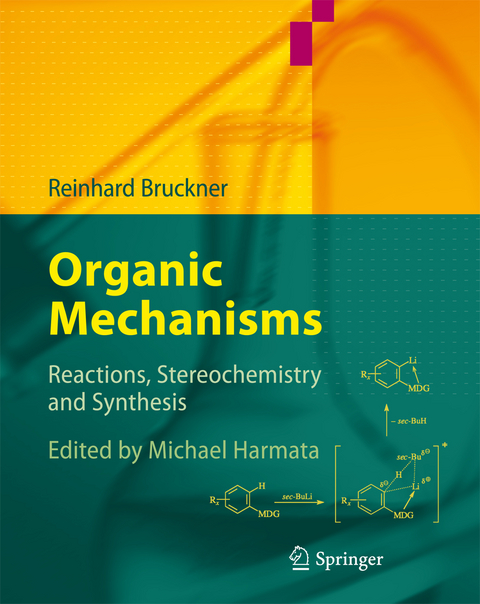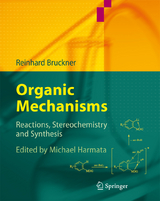Organic Mechanisms
Springer Berlin (Verlag)
978-3-642-03650-7 (ISBN)
Prof. Dr. Reinhard Brückner arbeitet seit 1998 am Institut für Organische Chemie und Biochemie der Universität Freiburg. Arbeitsschwerpunkte: Naturstoffsynthese und Entwicklung neuer Methoden im Bereich der Stereoselektiven Synthese. Zuvor war er Professor für Organische Chemie an den Universitäten Würzburg und Göttingen bzw. Gastprofessor an der University of Wisconsin in Madison (USA), der Universidade de Santiago de Compostela (Spanien), der Indiana University Bloomington (USA) und der Tokyo University (Center of Excellence Program).
Radical Substitution Reactions at the Saturated C Atom.- Nucleophilic Substitution Reactions at the Saturated C Atom.- Electrophilic Additions to the C=C Double Bond.- ?-Eliminations.- Substitution Reactions on Aromatic Compounds.- Nucleophilic Substitution Reactions at the Carboxyl Carbon.- Carboxylic Compounds, Nitriles, and Their Interconversion.- Carbonic Acid Derivatives and Heterocumulenes and Their Interconversion.- Additions of Heteroatom Nucleophiles to Carbonyl Compounds and Subsequent Reactions-Condensations of Heteroatom Nucleophiles with Carbonyl Compounds.- Addition of Hydride Donors and of Organometallic Compounds to Carbonyl Compounds.- Conversion of Phosphorus- or Sulfur-Stabilized C Nucleophiles with Carbonyl Compounds: Addition-induced Condensations.- The Chemistry of Enols and Enamines.- Chemistry of the Alkaline Earth Metal Enolates.- Rearrangements.- Thermal Cycloadditions.- Transition Metal-Mediated Alkenylations, Arylations, and Alkynylations.- Oxidations and Reductions.
From the reviews:
"The new edition of the textbook of R. Bruckner is accurate, all important modern mechanistic and synthetic concepts of organic chemistry are presented in a very didactic fashion, a superb book to put in the hands of all who would want to learn synthetic organic chemistry or refresh their knowledge."
Paul Knochel, Ludwig-Maximilians-University Munich
"Over its three editions, Professor Bruckner has significantly fine-tuned his outstanding textbook titled 'Organic Mechanisms', now available in English. This text is aimed squarely at students that have completed a typical one-year introductory course in organic chemistry and now wish to continue refining their understanding of the subject. At this level, the text is appropriately focused on providing the reader with an enhanced fundamental understanding of an ambitious range of organic reactions. Along with reminding the reader about fundamental principles necessary to understand the topic, Bruckner's updated edition also provides a solid physical organic perspective on a wide range of processes. The text is not meant to be an exhaustive survey of reactions, but more of a sound introduction to the underlying principles that control reactivity in variety of transformations that chemistry students should be familiar with. The book, therefore, is particularly well suited for "intermediate" and "advanced" classes in organic chemistry, usually found in upper class electives and introductory graduate classes. The book will also serve as a valuable starting point for the more experienced chemist wishing to brush-up on organic transformations that they might be less familiar with."
Marc L. Snapper, Boston College
This updated version of Professor Brückner's 'Organic Mechanisms' provides a thorough overview of modern organic synthesis that is both comprehensive and accessible to chemists with all levels of experience.Detailed reaction mechanisms are illustrated with clear schemes that effectively convey the electronic and structural principles influencing reactivity and selectivity for the most common transformations used in organic synthesis. The pragmatic division of the material into introductory and more advanced sections enables the text to be used both as a teaching resource for both undergraduate chemistry students and researchers from allied disciplines and as a valuable text for experienced researchers. The book prompts the reader to readily grasp important concepts, while providing ample scope for extension and development of more advanced students of organic chemistry. 'Organic Mechanisms' is also a valuable resource for those involved in the application and practice of organic synthesis on a professional level. The range of topics discussed provides an up-to-date compendium of current methods, of relevance to both academia and industry, with the references at the end of each chapter providing a useful starting point for more detailed further reading. Overall, the new English edition of 'Organic Mechanisms' is an excellent single reference for those wishing to learn or better understand the complex practice of modern synthetic organic chemistry. It is long overdue and I look forward to having a copy readily available for my students.
Margaret Brimble, The University of Auckland
Having held in high regard the 1st English edition of Bruckner´s textbook Organic Reaction Mechanisms I have been waiting for years for an updated version to appear. This long-expected textbook is now available. It has been completely revised and considerably expanded and is a meticulously composed treatise at the interface between synthetic organic chemistry and mechanistic analysis. Every student of advanced organic chemistry will benefit from this book."
Koichi Narasaka, Nayang Technical University, Singapore.
"This English edition of the Germantextbook by Bruckner ... is an excellent resource for advanced academic students. ... The presentation is impressive, and clear illustrations appear throughout the book. ... This makes the work a very interesting read and offers abundant opportunities for students to create new problem sets. ... For graduate students and instructors, this work offers a wealth of information. The end-of-chapter references are comprehensive and thorough. Summing Up: Highly recommended. Graduate students, researchers/faculty, and professionals." (S. Rajaraman, Choice, Vol. 48 (3), November, 2010)
From the reviews:"The new edition of the textbook of R. Bruckner is accurate, all important modern mechanistic and synthetic concepts of organic chemistry are presented in a very didactic fashion, a superb book to put in the hands of all who would want to learn synthetic organic chemistry or refresh their knowledge."Paul Knochel, Ludwig-Maximilians-University Munich "Over its three editions, Professor Bruckner has significantly fine-tuned his outstanding textbook titled ‘Organic Mechanisms’, now available in English. This text is aimed squarely at students that have completed a typical one-year introductory course in organic chemistry and now wish to continue refining their understanding of the subject. At this level, the text is appropriately focused on providing the reader with an enhanced fundamental understanding of an ambitious range of organic reactions. Along with reminding the reader about fundamental principles necessary to understand the topic, Bruckner’s updated edition also provides a solid physical organic perspective on a wide range of processes. The text is not meant to be an exhaustive survey of reactions, but more of a sound introduction to the underlying principles that control reactivity in variety of transformations that chemistry students should be familiar with. The book, therefore, is particularly well suited for “intermediate” and “advanced” classes in organic chemistry, usually found in upper class electives and introductory graduate classes. The book will also serve as a valuable starting point for the more experienced chemist wishing to brush-up on organic transformations that they might be less familiar with.” Marc L. Snapper, Boston CollegeThis updated version of Professor Brückner’s ‘Organic Mechanisms’ provides a thorough overview of modern organic synthesis that is both comprehensive and accessible to chemists with all levels of experience.Detailed reaction mechanisms are illustrated with clear schemes that effectively convey the electronic and structural principles influencing reactivity and selectivity for the most common transformations used in organic synthesis. The pragmatic division of the material into introductory and more advanced sections enables the text to be used both as a teaching resource for both undergraduate chemistry students and researchers from allied disciplines and as a valuable text for experienced researchers. The book prompts the reader to readily grasp important concepts, while providing ample scope for extension and development of more advanced students of organic chemistry. ‘Organic Mechanisms’ is also a valuable resource for those involved in the application and practice of organic synthesis on a professional level. The range of topics discussed provides an up-to-date compendium of current methods, of relevance to both academia and industry, with the references at the end of each chapter providing a useful starting point for more detailed further reading. Overall, the new English edition of ‘Organic Mechanisms’ is an excellent single reference for those wishing to learn or better understand the complex practice of modern synthetic organic chemistry. It is long overdue and I look forward to having a copy readily available for my students. Margaret Brimble, The University of AucklandHaving held in high regard the 1st English edition of Bruckner´s textbook Organic Reaction Mechanisms I have been waiting for years for an updated version to appear. This long-expected textbook is now available. It has been completely revised and considerably expanded and is a meticulously composed treatise at the interface between synthetic organic chemistry and mechanistic analysis. Every student of advanced organic chemistry will benefit from this book." Koichi Narasaka, Nayang Technical University, Singapore.“This English edition of the Germantextbook by Bruckner … is an excellent resource for advanced academic students. … The presentation is impressive, and clear illustrations appear throughout the book. … This makes the work a very interesting read and offers abundant opportunities for students to create new problem sets. … For graduate students and instructors, this work offers a wealth of information. The end-of-chapter references are comprehensive and thorough. Summing Up: Highly recommended. Graduate students, researchers/faculty, and professionals.” (S. Rajaraman, Choice, Vol. 48 (3), November, 2010)
| Erscheint lt. Verlag | 20.1.2010 |
|---|---|
| Illustrationen | Wolfgang Zettlmeier |
| Vorwort | Paul Wender |
| Zusatzinfo | XXXII, 855 p. |
| Verlagsort | Berlin |
| Sprache | englisch |
| Maße | 193 x 242 mm |
| Gewicht | 2065 g |
| Themenwelt | Naturwissenschaften ► Biologie ► Biochemie |
| Naturwissenschaften ► Chemie ► Organische Chemie | |
| Schlagworte | Cycloaddition • Electrophilic addition • mechanisms • Nucleophilic substitution • Organic Chemistry • Organische Chemie • Reactions • Reaktionen (chem., physikal.) • rearrangement • Stereochemie • Synthese (chem.) • synthesis • Textbook |
| ISBN-10 | 3-642-03650-3 / 3642036503 |
| ISBN-13 | 978-3-642-03650-7 / 9783642036507 |
| Zustand | Neuware |
| Informationen gemäß Produktsicherheitsverordnung (GPSR) | |
| Haben Sie eine Frage zum Produkt? |
aus dem Bereich




